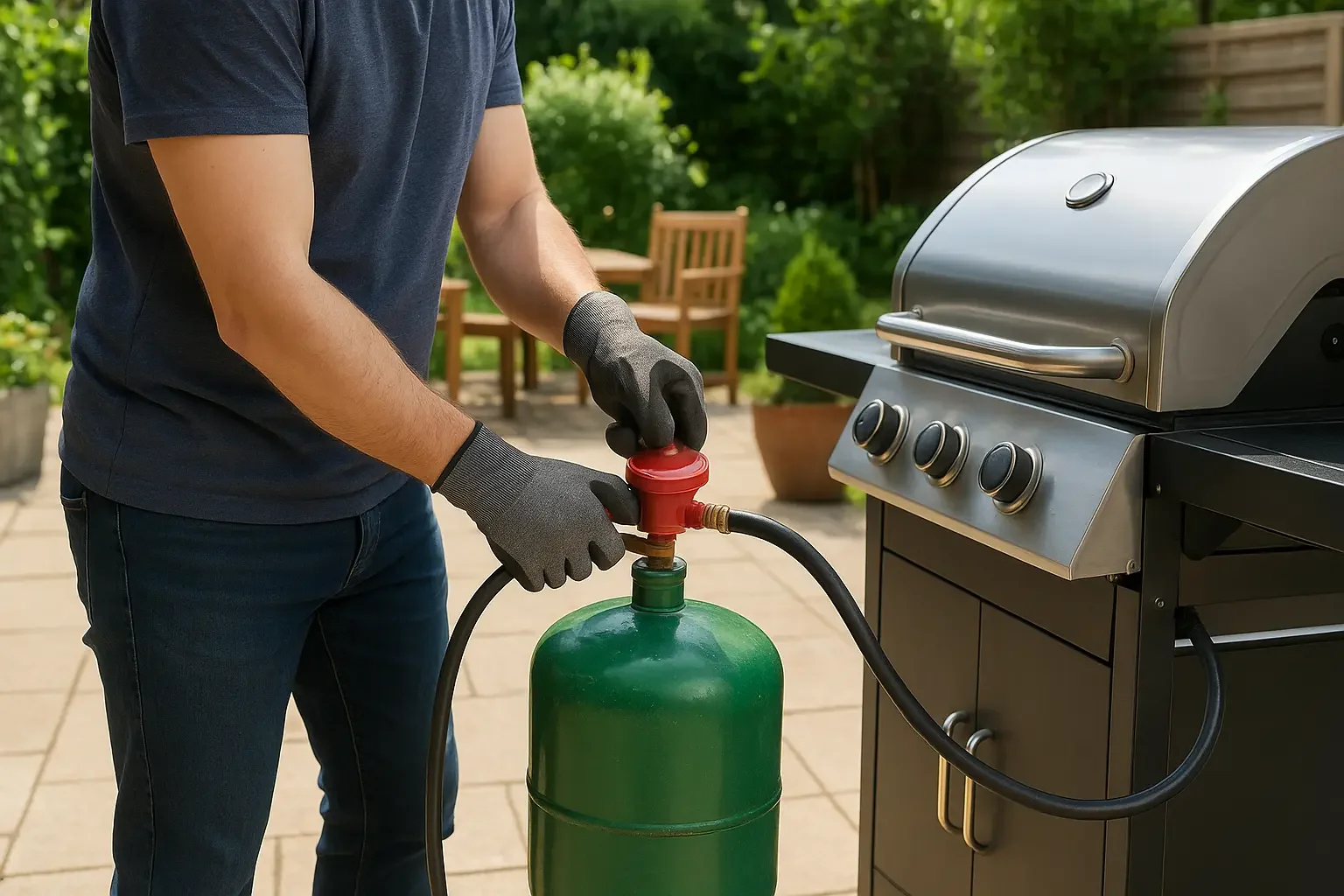The Ultimate Guide to Connecting a Patio Gas Bottle Safely
Connecting a patio gas bottle may seem like a simple task, but doing it the right way is essential for safety, performance, and peace of mind. Whether you’re setting up a patio heater, gas BBQ, or outdoor cooking appliance, this guide will walk you through every step to ensure you connect your patio gas bottle safely and confidently.
Understanding What a Patio Gas Bottle Is
A patio gas bottle is a pressurised container filled with propane gas designed for outdoor use. It’s the most common fuel source for patio heaters, gas BBQs, and camping stoves. These bottles are equipped with a screw-on or clip-on regulator that controls the flow of gas to your appliance.
Patio gas is ideal for outdoor conditions because propane performs well even in cold weather. This makes the patio gas bottle perfect for year-round outdoor heating and entertaining.
Why Safety Matters When Connecting a Patio Gas Bottle
Handling gas always requires caution. If connected incorrectly, leaks or regulator faults can lead to fire hazards or wasted gas. By following the right steps, you’ll ensure your equipment operates efficiently and safely every time.
Proper connection also prolongs the life of your patio gas bottle and prevents damage to the regulator or hose.
Tools and Materials You’ll Need
Before you begin, make sure you have the following items ready:
A compatible patio gas bottle (usually 5kg or 13kg propane)
The correct regulator (clip-on or screw-on, depending on your bottle type)
A gas hose in good condition
Soapy water for leak testing
Adjustable spanner (if needed)
A flat, stable outdoor surface for setup
Having everything prepared before you start ensures a smooth and safe connection process.
Step-by-Step Guide to Connecting a Patio Gas Bottle Safely
1. Check for Damage
Inspect the patio gas bottle for dents, rust, or leaks. Check the rubber hose for cracks or signs of wear. Replace any damaged parts before use. Never use a damaged bottle or hose.
2. Ensure the Appliance Is Turned Off
Always make sure your gas BBQ or heater is switched off before connecting the gas. This prevents accidental ignition.
3. Identify the Regulator Type
Most patio gas bottles use a 27mm clip-on propane regulator, which easily snaps onto the bottle’s valve. Some may use a screw-on type. Check your equipment’s manual to confirm.
4. Attach the Regulator
Remove the protective cap from the gas bottle valve.
Line up the regulator connection with the valve.
For clip-on regulators: push down firmly until you hear a “click.”
For screw-on regulators: tighten with an adjustable spanner, but do not overtighten.
Make sure the regulator is seated properly — it should not wobble or move once attached.
5. Check for Leaks
Once the patio gas bottle is connected, mix a little dish soap with water and apply it to the valve and hose connection points.
Turn on the gas supply slightly — if you see bubbles forming, there’s a leak. Turn off the gas immediately, disconnect the regulator, and refit it properly. Repeat the test until no bubbles appear.
6. Ignite the Appliance
After confirming there are no leaks, turn on your gas appliance and ignite it according to the manufacturer’s instructions. You should get a steady blue flame — a sign of proper gas flow.
7. Store and Secure the Bottle
When not in use, always store your patio gas bottle upright in a well-ventilated outdoor area. Avoid placing it near direct sunlight, heat sources, or flammable materials.
Tips for Long-Term Patio Gas Safety
Always turn off the regulator first before disconnecting the hose.
Keep the bottle upright at all times.
Regularly check your equipment for signs of corrosion or wear.
Never attempt to refill a patio gas bottle yourself — always exchange it at an authorised retailer.
Store bottles away from children and pets.
Replace your gas hose every 3–5 years for safety.
Following these practices ensures your patio gas bottle operates safely throughout the year.
How to Disconnect a Patio Gas Bottle
When it’s time to disconnect your patio gas bottle, follow these quick steps:
Turn off your gas appliance and close the bottle’s valve.
For clip-on regulators, lift the switch or lever to release the connection.
For screw-on types, use a spanner to gently loosen the fitting.
Replace the protective cap on the bottle’s valve.
Store the bottle in a safe, upright position outdoors.
Never disconnect a hot or active appliance — always allow it to cool first.
Common Mistakes to Avoid When Connecting a Patio Gas Bottle
Even experienced users sometimes make small mistakes that can lead to gas leaks or appliance damage. Avoid these common errors:
Forcing the regulator onto the valve — it should click or screw on smoothly.
Using indoor hoses or regulators on outdoor equipment.
Skipping the leak test — even if it looks fine, always check with soapy water.
Placing the bottle horizontally — it must always stay upright to function safely.
Leaving the valve open when not in use — this can cause slow gas leaks over time.
By steering clear of these mistakes, you’ll ensure your patio gas bottle remains in top condition and safe to use.
When to Replace or Refill Your Patio Gas Bottle
If you notice your heater or BBQ flame weakening, your bottle may be running low. Some bottles have a visible gas level indicator, but many do not. As a general rule, 13kg bottles last longer for frequent BBQ users, while 5kg bottles are perfect for occasional outdoor heating.
Always exchange your patio gas bottle at an authorised dealer to guarantee proper refilling and safety checks. Never attempt to refill it yourself or at unverified stations.
Eco-Friendly Disposal of Old Patio Gas Bottles
When your bottle is no longer usable, return it to the retailer or supplier. Most companies reuse or recycle the cylinders. Do not throw a patio gas bottle into household waste — it’s a pressurised container and must be handled professionally.
Frequently Asked Questions (FAQ)
1. Can I use a propane regulator on any patio gas bottle?
No, you should always use a regulator that matches your patio gas bottle type. Most patio gas bottles use a 27mm clip-on regulator, but always check the manufacturer’s label before connecting.
2. How do I know if my patio gas bottle is leaking?
You can detect a leak by spraying soapy water around the valve and connections. If you see bubbles forming, turn off the gas immediately and reconnect the regulator securely.
3. Can I store my patio gas bottle indoors?
It’s not recommended. Always store your patio gas bottle outdoors, in a shaded, well-ventilated space, away from sources of heat and direct sunlight.
4. How often should I replace the hose and regulator?
Gas hoses should be replaced every 3–5 years, and regulators every 5–10 years, depending on usage and condition. Always check the date stamp on your equipment.
5. Why won’t my patio heater ignite even though the gas bottle is full?
There might be a blockage in the hose or a faulty regulator. Disconnect the patio gas bottle, check for obstructions, and reconnect it securely.
Final Thoughts
Connecting a patio gas bottle safely doesn’t have to be complicated — it just requires attention to detail and a bit of care. By following these simple steps, you can enjoy your outdoor BBQs, patio heaters, and garden gatherings with confidence and peace of mind.
Remember: always check for leaks, store your bottle correctly, and use compatible parts. When handled properly, a patio gas bottle is one of the most convenient and efficient fuel options for outdoor living.

